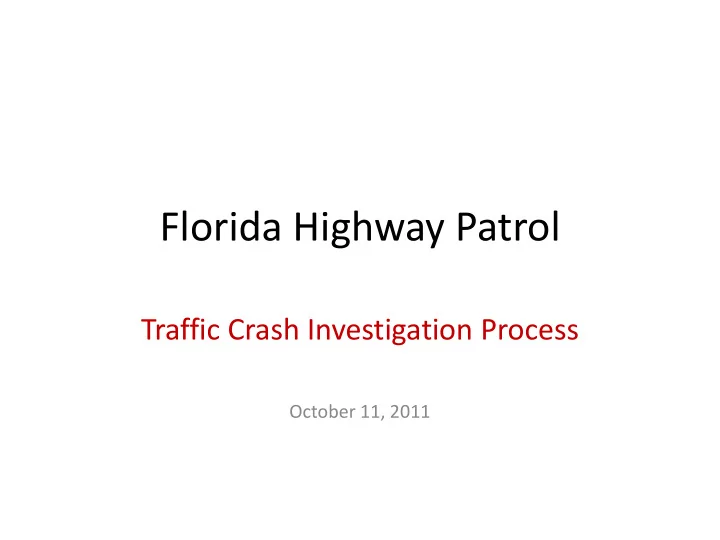

Florida Highway Patrol Traffic Crash Investigation Process October 11, 2011
Trooper Receives Call From FMRCC
Trooper Dispatched To Crash Scene Given Information Regarding Location of Crash, Vehicle Descriptions, Roadblock, and/or Injuries.
Trooper Arrives on Crash Scene ** Observes the scene upon arrival ** Speaks with Emergency Personnel ** Locates witnesses / interviews ** Investigates for Impaired Driver ** Records roadway evidence ** Calls for tow trucks ** Completes Crash Report
Observes the Crash Scene
Record Roadway Evidence
Completes the Traffic Crash Report
Traffic Homicide Investigations
THI Investigates Fatal Crashes
THI Corporals Go Beyond The Crash Report
Tools of the Trade
Utilizing the Drag Sled
Using Drag Sled on Different Surfaces
Multiple Surfaces Have Different Drag Factors Grass - Concrete - Pavement
THI Equation Handbook Used for Reconstruction of Traffic Crash
iWitness Photogrammetry
Open Roads Policy
In 2002 FDOT / FHP agreed to utilize “close range photogrammetry” as a tool to reduce scene time at crashes Close Range Photogrammetry allowed troopers to reduce their on-scene time by photographing the crash and later “mapping the crash” using a computer back in the office. Only Corporals have this capability.
Measurements with Camera
Utilizing markers, the iWitness software solves for the camera positions and 3D coordinates the markers to produce an image-based diagram.
Each marker is labeled and measured by the iWitness software to produce marker points for the CAD drawing
iWitness Summary Report • iWitness Project Summary (25/03/2011 13:05pm) • _______________________________________________________________________________ • Project Name: FHP711-64-001_1.iwp • Camera name(s): OLYMPUS IMAGING CORP. E-500 (unique ID: A70508025_01-04-11) • Scale Set?: Yes • Number of images: 33 • Number of referenced points: 25 • Number of cameras: 1 • Quality of geometry: 1.0 (good) • Minimum number of points on an image: 0 on image: P1051661.JPG P1051662.JPG • P1051663.JPG P1051664.JPG P1051666.JPG P1051667.JPG P1051668.JPG P1051669.JPG • P1051670.JPG P1051671.JPG P1051672.JPG P1051673.JPG P1051674.JPG P1051675.JPG • P1051676.JPG P1051677.JPG P1051678.JPG P1051679.JPG P1051680.JPG P1051681.JPG • P1051682.JPG P1051683.JPG P1051684.JPG P1051685.JPG P1051686.JPG P1051687.JPG • P1051688.JPG P1051689.JPG P1051690.JPG • Minimum point intersection angle: 3 degs for point: 25 • Number of points referenced on: • 2 images only: 0 • 3 or more images: 25 • 4 or more images: 12 • 6 or more images: 0 • Estimated accuracy of 3D point coordinates (RMS 1-Sigma): • X: 0.0632 feet, or 1:2600 • Y: 0.3392 feet, or 1:400 • Z: 0.0159 feet, or 1:10600 • Overall: 0.1394 feet, or 1:1200 • Estimated accuracy of image referencing: 0.48 pixels • Quality of self-calibration (if applied): N/A • 3D coordinate text file: Control1.txt • 3D coordinate DXF file: Network1.dxf
Summary Report Transferred to Crash Zone
Completed diagrams are then digitally drawn by Crash Zone to duplicate to scale of the crash scene
Conclusion ** Trooper is dispatched to crash. ** Conducts crash investigation ** Completes crash report ** Clears scene ** If fatal crash, Corporal is called ** Photos & Measurements are taken ** Drag Sled ** Interview of witnesses ** Photogrammetry utilized ** Medical Examiner notified ** Evidence collected and identified ** Scene cleared
Recommend
More recommend